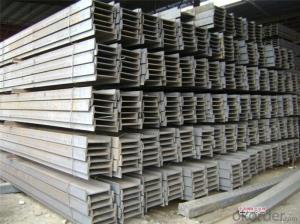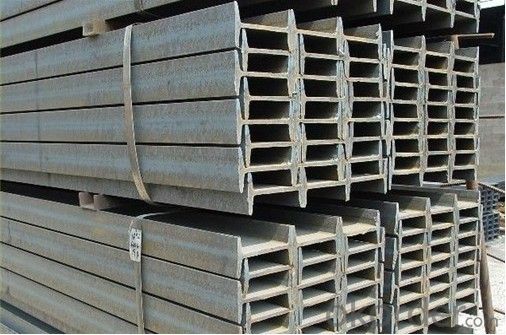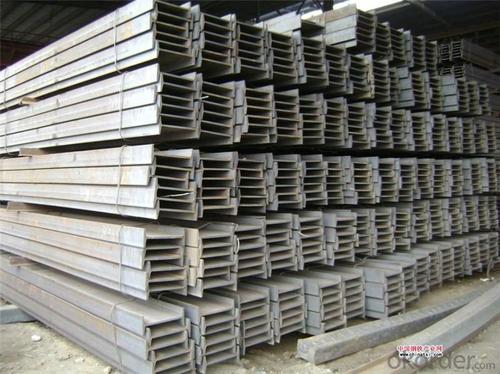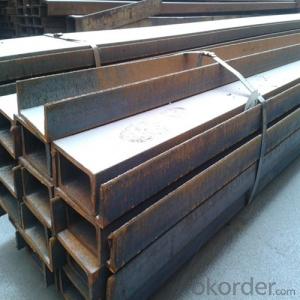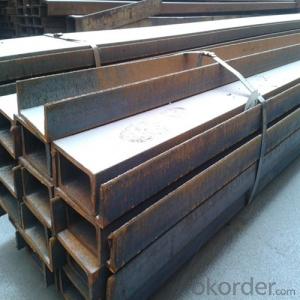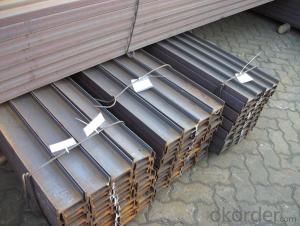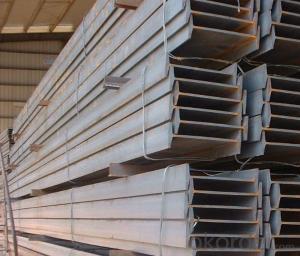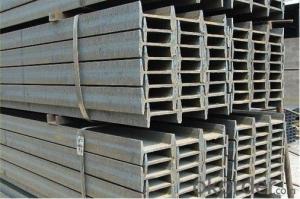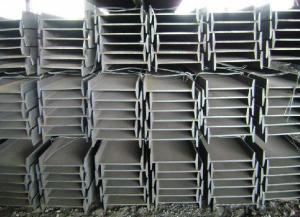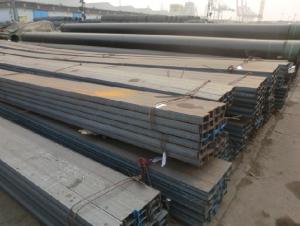Hot Rolled IPE and IPEAA Beam in Q235B Grade
- Loading Port:
- Tianjin
- Payment Terms:
- TT OR LC
- Min Order Qty:
- 25 m.t.
- Supply Capability:
- 10000 m.t./month
OKorder Service Pledge
OKorder Financial Service
You Might Also Like
Product Description:
OKorder is offering high quality Hot Rolled Steel I-Beams at great prices with worldwide shipping. Our supplier is a world-class manufacturer of steel, with our products utilized the world over. OKorder annually supplies products to European, North American and Asian markets. We provide quotations within 24 hours of receiving an inquiry and guarantee competitive prices.
Product Applications:
Hot Rolled Steel I-Beams are ideal for structural applications and are widely used in the construction of buildings and bridges, and the manufacturing, petrochemical, and transportation industries.
Product Advantages:
OKorder's Steel I-Beams are durable, strong, and resist corrosion.
Main Product Features:
· Premium quality
· Prompt delivery & seaworthy packing (30 days after receiving deposit)
· Corrosion resistance
· Can be recycled and reused
· Mill test certification
· Professional Service
· Competitive pricing
Product Specifications:
Manufacture: Hot rolled
Grade: Q195 – 235
Certificates: ISO, SGS, BV, CIQ
Length: 6m – 12m, as per customer request
Packaging: Export packing, nude packing, bundled
Chinese Standard (H*W*T) | Weight (Kg/m) | 6m (pcs/ton) | Light I (H*W*T) | Weight (Kg/m) | 6m (pcs/ton) | Light II (H*W*T) | Weight (Kg/m) | 6M |
100*68*4.5 | 11.261 | 14.8 | 100*66*4.3 | 10.13 | 16.4 | 100*64*4 | 8.45 | 19.7 |
120*74*5.0 | 13.987 | 11.9 | 120*72*4.8 | 12.59 | 13.2 | 120*70*4.5 | 10.49 | 15.8 |
140*80*5.5 | 16.89 | 9.8 | 140*78*5.3 | 15.2 | 10.9 | 140*76*5 | 12.67 | 13.1 |
160*88*6 | 20.513 | 8.1 | 160*86*5.8 | 18.46 | 9 | 160*84*5.5 | 15.38 | 10.8 |
180*94*6.5 | 24.143 | 6.9 | 180*92*6.3 | 21.73 | 7.6 | 180*90*6 | 18.11 | 9.2 |
200*100*7 | 27.929 | 5.9 | 200*98*6.8 | 25.14 | 6.6 | 200*96*6.5 | 20.95 | 7.9 |
220*110*7.5 | 33.07 | 5 | 220*108*7.3 | 29.76 | 5.6 | 220*106*7 | 24.8 | 6.7 |
250*116*8 | 38.105 | 4.3 | 250*114*7.8 | 34.29 | 4.8 | 250*112*7.5 | 28.58 | 5.8 |
280*122*8.5 | 43.492 | 3.8 | 280*120*8.2 | 39.14 | 4.2 | 280*120*8 | 36.97 | 4.5 |
300*126*9 | 48.084 | 3.4 | 300*124*9.2 | 43.28 | 3.8 | 300*124*8.5 | 40.87 | 4 |
320*130*9.5 | 52.717 | 3.1 | 320*127*9.2 | 48.5 | 3.4 | |||
360*136*10 | 60.037 | 2.7 | 360*132*9.5 | 55.23 | 3 |
FAQ:
Q1: Why buy Materials & Equipment from OKorder.com?
A1: All products offered byOKorder.com are carefully selected from China's most reliable manufacturing enterprises. Through its ISO certifications, OKorder.com adheres to the highest standards and a commitment to supply chain safety and customer satisfaction.
Q2: What makes stainless steel stainless?
A2: Stainless steel must contain at least 10.5 % chromium. It is this element that reacts with the oxygen in the air to form a complex chrome-oxide surface layer that is invisible but strong enough to prevent further oxygen from "staining" (rusting) the surface. Higher levels of chromium and the addition of other alloying elements such as nickel and molybdenum enhance this surface layer and improve the corrosion resistance of the stainless material.
Q3: Can stainless steel rust?
A3: Stainless does not "rust" as you think of regular steel rusting with a red oxide on the surface that flakes off. If you see red rust it is probably due to some iron particles that have contaminated the surface of the stainless steel and it is these iron particles that are rusting. Look at the source of the rusting and see if you can remove it from the surface.
Images:
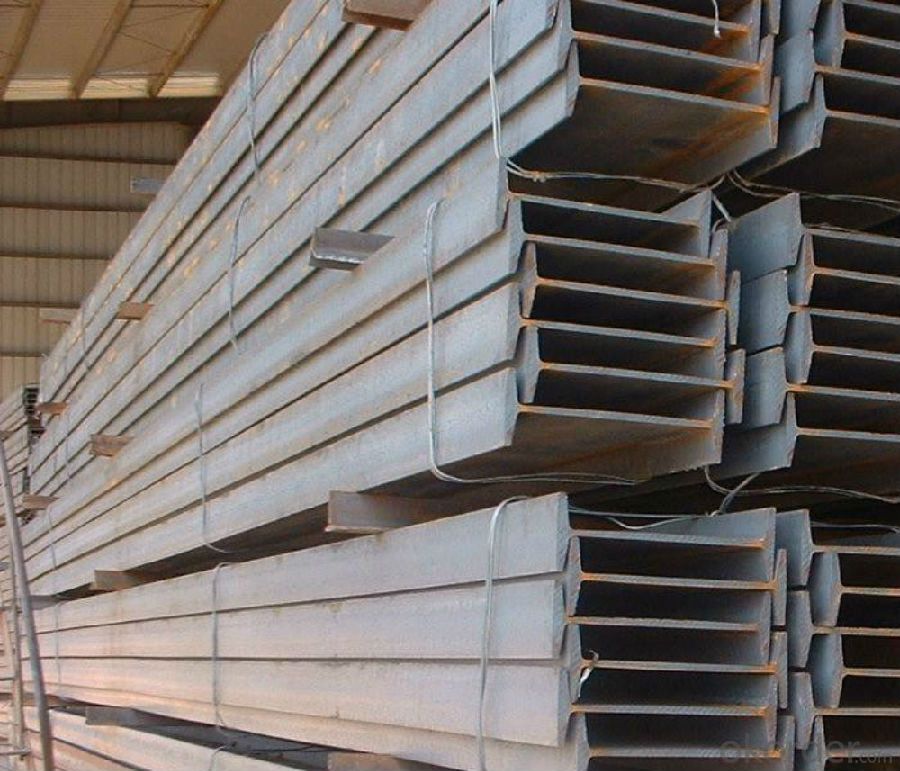

- Q: What is the maximum span for steel I-beams?
- The maximum span for steel I-beams can vary depending on various factors such as the specific type and size of the beam, the load it needs to support, and the local building codes and regulations. However, in general, steel I-beams can have spans ranging from a few feet to over 100 feet.
- Q: How are steel I-beams used in construction?
- Steel I-beams are commonly used in construction due to their strength and versatility. They are structural components that can support heavy loads and provide stability in various types of construction projects. One of the primary uses of steel I-beams is in the construction of buildings and bridges. They are often used as load-bearing supports in the framework of these structures. The I-shape of the beam allows it to distribute the weight evenly across its length, making it ideal for supporting the weight of floors, walls, and roofs. In addition to supporting vertical loads, steel I-beams can also withstand horizontal forces such as wind or seismic activity. This is crucial for ensuring the stability and safety of buildings, especially in areas prone to natural disasters. Steel I-beams are also used in the construction of industrial facilities and warehouses. These structures often require wide open spaces without the need for additional columns or support walls. The strength and rigidity of I-beams allow for the creation of large, uninterrupted spaces that can accommodate heavy machinery or storage systems. Furthermore, steel I-beams are commonly used in the construction of bridges. The long spans required in bridge construction demand strong and durable materials. Steel I-beams provide the necessary strength while minimizing the weight of the structure, making them ideal for spanning large distances. Overall, steel I-beams are a crucial component in construction projects, providing structural support, stability, and versatility. Their ability to withstand heavy loads and distribute them efficiently makes them an essential element in building safe and sturdy structures.
- Q: What does "I-beam 600*200*8*12" mean?
- This is the information of i-beam:The height is 600mm, the thickness is 8mm, the width is 200mm, and the thickness is 12mm.
- Q: Can steel I-beams be used for airport terminals?
- Yes, steel I-beams can be used for airport terminals. They are commonly used in the construction of large buildings and structures due to their high strength and load-bearing capabilities. Steel I-beams provide stability and durability, making them suitable for supporting the heavy loads and long spans typically required in airport terminal constructions.
- Q: Do you use brackets made of I-beam and angle steel to make the following?
- The general I-beam is the main structure, and the angle steel is the supporting structure. This is a general general consideration in the design of steel structures.
- Q: How do steel I-beams contribute to sustainable building practices?
- Steel I-beams contribute to sustainable building practices in several ways. Firstly, steel is one of the most sustainable building materials available. It is 100% recyclable, which means that any steel used in construction can be easily and efficiently repurposed at the end of a building's life cycle. This reduces the need for new raw materials and minimizes waste. Secondly, steel I-beams are incredibly durable and long-lasting. They have a high strength-to-weight ratio, which means that they can support heavy loads without adding excessive weight to the structure. This durability reduces the need for frequent repairs or replacements, resulting in lower maintenance costs and less waste over time. Moreover, steel I-beams can be prefabricated off-site and then transported to the construction site. This process requires less energy and resources compared to on-site fabrication, reducing the carbon footprint of the building project. Additionally, the use of prefabricated steel components can significantly decrease construction time, leading to less disruption to the surrounding environment and a more efficient use of resources. Furthermore, steel I-beams can be designed to maximize energy efficiency in buildings. They can support the integration of insulation materials, allowing for better thermal performance and reducing the need for excessive heating or cooling. Additionally, steel can be used in combination with other sustainable building systems, such as renewable energy technologies or green roofs, to further enhance the overall sustainability of the building. Lastly, steel I-beams are resistant to fire, pests, and extreme weather conditions, making them a reliable choice for sustainable construction. The longevity of steel structures reduces the need for frequent rebuilding, saving resources and minimizing the environmental impact of the construction industry. In conclusion, steel I-beams contribute to sustainable building practices by being recyclable, durable, energy-efficient, and resistant to various hazards. Their use in construction promotes resource conservation, reduces waste, and helps create environmentally friendly buildings that can endure for generations.
- Q: What are the design considerations for using steel I-beams?
- When incorporating steel I-beams into structural design, it is important to keep in mind several key considerations. Firstly, the load-bearing capacity of the I-beams must be taken into account. This involves ensuring that the beams can adequately support the anticipated loads, including both dead loads and live loads. It is necessary to select I-beams of appropriate size, shape, and material properties to achieve the necessary strength without excessive deflection or failure. Secondly, the span length and spacing between the I-beams are critical factors to consider. Longer spans require larger and stronger beams to prevent excessive deflection. The spacing between the beams should be determined based on the anticipated loads and the required stiffness of the structure. Properly spacing the I-beams is essential for even load distribution and to ensure the structural integrity of the building or bridge. Thirdly, the connection details between the steel I-beams and other structural elements are crucial for overall stability and strength. Different methods, such as welding, bolting, or a combination of both, can be used to connect the beams to columns, foundations, or other supporting elements. The connection design should consider factors such as load transfer, shear and moment resistance, and compatibility with the surrounding materials. Fourthly, fire resistance is an important consideration when using steel I-beams in buildings. Although steel is a non-combustible material, it can lose its strength when exposed to high temperatures. Therefore, measures should be taken to enhance the fire resistance of the steel beams, such as fire-rated insulation, intumescent coatings, or encasement with fire-resistant materials. These measures ensure the structural integrity of the steel beams in the event of a fire. Lastly, the cost and availability of steel I-beams should be taken into consideration. Factors such as the size, grade, and fabrication requirements of the beams can impact their cost. Additionally, availability can be influenced by local steel suppliers, manufacturing lead times, and transportation logistics. It is important to strike a balance between the desired design, cost-efficiency, and accessibility when selecting steel I-beams. In conclusion, the design considerations for incorporating steel I-beams into structural design include assessing load-bearing capacity, span length and spacing, connection details, fire resistance, and cost and availability. Careful evaluation of these factors is crucial to ensure a safe and structurally sound design using steel I-beams.
- Q: Which bearing capacity is stronger?
- Both I-beam and channel steel should be used as beam members, and the bending moment can be greater than that of other kinds of materials under two weight conditions. Because when it is used as a beam, the stress produced by the bending moment is X type, the stress at the top and the lower part of the beam is maximum, and the middle part is smaller, while the I-beam and the channel steel are both the top and the bottom.
- Q: What are the different types of steel I-beam connections for roof framing?
- There are several different types of steel I-beam connections used for roof framing, each with its own advantages and applications. 1. Welded Connection: This is one of the most common and straightforward methods of connecting steel I-beams for roof framing. It involves welding the ends of the beams together, creating a strong and rigid connection. Welded connections are often used for heavy loads and where structural stability is crucial. 2. Bolted Connection: In this method, steel plates or angles are bolted to the flanges of the I-beams, creating a connection that can be easily disassembled if needed. Bolted connections are versatile and can accommodate different beam sizes and angles, making them suitable for various roof framing designs. 3. Gusset Plate Connection: A gusset plate is a steel plate that is welded or bolted to the webs of two I-beams, effectively joining them together. This type of connection is commonly used in roof framing to transfer loads and provide additional strength and stability. Gusset plate connections are ideal for situations where there is a need for load-bearing capacity and resistance against lateral forces. 4. Moment Connection: A moment connection is a more complex type of connection that allows for the transfer of bending moments between two beams. It involves welding or bolting additional steel plates and angles to the flanges and webs of the I-beams. Moment connections are typically used in large-span roof structures or where there is a need to resist lateral and vertical loads. 5. Cleat Connection: Cleats are steel plates that are attached to the flanges of two I-beams using bolts or welding. This type of connection is commonly used when there is a need to join beams at an angle or connect beams to other structural elements such as columns or walls. Cleat connections provide flexibility in design and ease of installation. It is important to consider factors such as load requirements, structural stability, and ease of assembly when selecting the appropriate type of steel I-beam connection for roof framing. Consulting with a structural engineer or a roofing professional can help determine the most suitable connection method for a specific project.
- Q: Can steel I-beams be used for manufacturing plants?
- Yes, steel I-beams can be used for manufacturing plants. Steel I-beams are commonly used in the construction industry due to their high strength-to-weight ratio and versatility. They provide excellent structural support and can withstand heavy loads, making them ideal for use in manufacturing plants where heavy machinery and equipment are commonly used. Steel I-beams also offer long-term durability, as they are resistant to corrosion and can withstand harsh environmental conditions. Additionally, their ease of installation and ability to be customized to specific project requirements make steel I-beams a popular choice for manufacturing plants.
Send your message to us
Hot Rolled IPE and IPEAA Beam in Q235B Grade
- Loading Port:
- Tianjin
- Payment Terms:
- TT OR LC
- Min Order Qty:
- 25 m.t.
- Supply Capability:
- 10000 m.t./month
OKorder Service Pledge
OKorder Financial Service
Similar products
Hot products
Hot Searches

